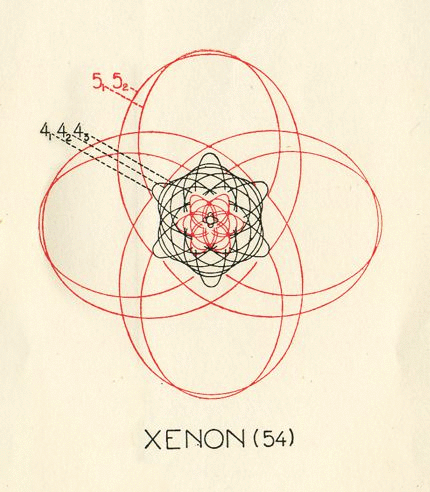The (former) U.S. Atomic Energy Commission had a seal showing a symbolic view of the atom that is unrealistic but instantly recognizable:
Source: https://blog.nuclearsecrecy.com/2012/04/13/friday-image-the-atomic-energy-commission-seal-1949/
This symbol was part of the visual language of the atomic age, used by towns, Disney, General Electric, and unicode (U+269B) starting in 1948 or earlier.
Taking the depicted image literally, this would represent the atom beryllium (because it shows 4 electrons). The blog author in the source points out that the most important part for nuclear energy (the nucleus) might have been shown with more detail. In fact, the current agency uses the word "nuclear" instead of "atomic".
While we know today that electrons behave very differently, I am wondering why the electrons are shown in orbits that are at an angle to each other. Many cartoons of atomic structure do this (the most common one has three orthogonal orbits), and I am sure many pre-date this particular example.
If the inspiration for Bohr's model was the solar system, wouldn't you show the orbits all in the same plane, with different radii like in the solar system, like the image above? Was there something known at the time Bohr formulated the model (or before 1949, when the seal was created) that would motivate out-of-plane orbits (maybe angular momentum) while sticking with the inaccurate Bohr model? Or is this a purely artistic choice, helping to make the cartoon more compelling and three-dimensional?
UPDATE: ThisBohr's drawing do not look like today's textbook drawings of it. Here is a diagram of Xenon (1921-1923).
 Source: https://physicstoday.scitation.org/doi/10.1063/PT.3.1978
Source: https://physicstoday.scitation.org/doi/10.1063/PT.3.1978
The atomic whirl symbol for an atom is often associated with the Rutherford model, even if Rutherford said very little about the position or states of the electrons (perhaps because classical physics did not have a model without contradictions, and a satisfying model required the combination of experimental data with quantum theory). In Rutherford's 1911 book "Radioactive Substances and their Radiations", he states:

So he leaves open whether electrons are spherically distributed or present in concentric paths in a plane, and acknowledges the earlier hypothesis by Nagaoka of a positively charged center with electrons surrounding it in some way (Saturnian or otherwise). At this time, the neutron had not been discovered, and it was not clear where the high-energy electrons of beta radiation came from (from the nucleus or elsewhere).


